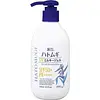What's inside
What's inside
 Key Ingredients
Key Ingredients

 Benefits
Benefits

 Concerns
Concerns

 Ingredients Side-by-side
Ingredients Side-by-side

Water
Skin ConditioningEthylhexyl Methoxycinnamate 9.5%
UV AbsorberAlcohol
AntimicrobialButyl Methoxydibenzoylmethane 1%
UV AbsorberOctocrylene 1%
UV AbsorberSteareth-6
EmulsifyingDimethicone
EmollientButylene Glycol
HumectantCarbomer
Emulsion StabilisingCoix Lacryma-Jobi Ma-Yuen Seed Extract
Skin ConditioningRosmarinus Officinalis Leaf Extract
AntimicrobialPrunus Persica Leaf Extract
EmollientAloe Barbadensis Leaf Extract
EmollientCitrus Junos Peel Oil
AstringentCocos Nucifera Oil
MaskingSodium Hyaluronate
HumectantCeramide Ng
Skin ConditioningXanthan Gum
EmulsifyingTetrasodium EDTA
Sodium Hydroxide 0.1%
BufferingBHT
AntioxidantMethylparaben 0.2%
PreservativeEthylparaben 0.01%
PreservativePhenoxyethanol 0.9%
PreservativeWater, Ethylhexyl Methoxycinnamate 9.5%, Alcohol, Butyl Methoxydibenzoylmethane 1%, Octocrylene 1%, Steareth-6, Dimethicone, Butylene Glycol, Carbomer, Coix Lacryma-Jobi Ma-Yuen Seed Extract, Rosmarinus Officinalis Leaf Extract, Prunus Persica Leaf Extract, Aloe Barbadensis Leaf Extract, Citrus Junos Peel Oil, Cocos Nucifera Oil, Sodium Hyaluronate, Ceramide Ng, Xanthan Gum, Tetrasodium EDTA, Sodium Hydroxide 0.1%, BHT, Methylparaben 0.2%, Ethylparaben 0.01%, Phenoxyethanol 0.9%
Water
Skin ConditioningPetrolatum
EmollientParaffinum Liquidum
EmollientGlycerin
HumectantStearic Acid
CleansingGlycol Stearate
EmollientGlyceryl Stearate
EmollientCera Microcristallina
Emulsion StabilisingTriethanolamine
BufferingCetyl Alcohol
EmollientStearamide Amp
Magnesium Aluminum Silicate
AbsorbentCarbomer
Emulsion StabilisingDisodium EDTA
BHT
AntioxidantParfum
MaskingPhenoxyethanol
PreservativeMethylparaben
PreservativePropylparaben
PreservativeAlpha-Isomethyl Ionone
PerfumingBenzyl Alcohol
PerfumingButylphenyl Methylpropional
PerfumingCitronellol
PerfumingGeraniol
PerfumingHexyl Cinnamal
PerfumingHydroxyisohexyl 3-Cyclohexene Carboxaldehyde
MaskingLimonene
PerfumingLinalool
PerfumingCI 77891
Cosmetic ColorantWater, Petrolatum, Paraffinum Liquidum, Glycerin, Stearic Acid, Glycol Stearate, Glyceryl Stearate, Cera Microcristallina, Triethanolamine, Cetyl Alcohol, Stearamide Amp, Magnesium Aluminum Silicate, Carbomer, Disodium EDTA, BHT, Parfum, Phenoxyethanol, Methylparaben, Propylparaben, Alpha-Isomethyl Ionone, Benzyl Alcohol, Butylphenyl Methylpropional, Citronellol, Geraniol, Hexyl Cinnamal, Hydroxyisohexyl 3-Cyclohexene Carboxaldehyde, Limonene, Linalool, CI 77891
 Reviews
Reviews

Ingredients Explained
These ingredients are found in both products.
Ingredients higher up in an ingredient list are typically present in a larger amount.
BHT is a synthetic antioxidant and preservative.
As an antioxidant, it helps your body fight off free-radicals. Free-radicals are molecules that may damage your skin cells.
As a preservative, it is used to stabilize products and prevent them from degrading. Specifically, BHT prevents degradation from oxidation.
The concerns related to BHT come from oral studies; this ingredient is currently allowed for use by both the FDA and EU.
However, it was recently restricted for use in the UK as of April 2024.
Learn more about BHTCarbomer is a polymer of acrylic acid. Its main role is to create a gel consistency.
A high amount of carbomer can cause pilling or balling up of products. Don't worry, most products contain 1% or less of carbomer.
Methylparaben is a preservative and is a paraben. It is used to prevent the growth of fungus, mold, and other harmful bacteria. Parabens are chemicals used as preservatives in both cosmetics and food.
Methylparaben can be synthetically created. It can also be found naturally in some fruits, such as blueberries.
Oftentimes, Methylparaben is combined with other parabens to help increase the shelf life.
The safety of Methylparaben is currently being studied. While ongoing studies are looking into the safety of parabens, the results have been very mixed. Some studies have not found Methylparaben to be harmful.
Learn more about MethylparabenPhenoxyethanol is a preservative that has germicide, antimicrobial, and aromatic properties. Studies show that phenoxyethanol can prevent microbial growth. By itself, it has a scent that is similar to that of a rose.
It's often used in formulations along with Caprylyl Glycol to preserve the shelf life of products.
Water. It's the most common cosmetic ingredient of all. You'll usually see it at the top of ingredient lists, meaning that it makes up the largest part of the product.
So why is it so popular? Water most often acts as a solvent - this means that it helps dissolve other ingredients into the formulation.
You'll also recognize water as that liquid we all need to stay alive. If you see this, drink a glass of water. Stay hydrated!
Learn more about Water